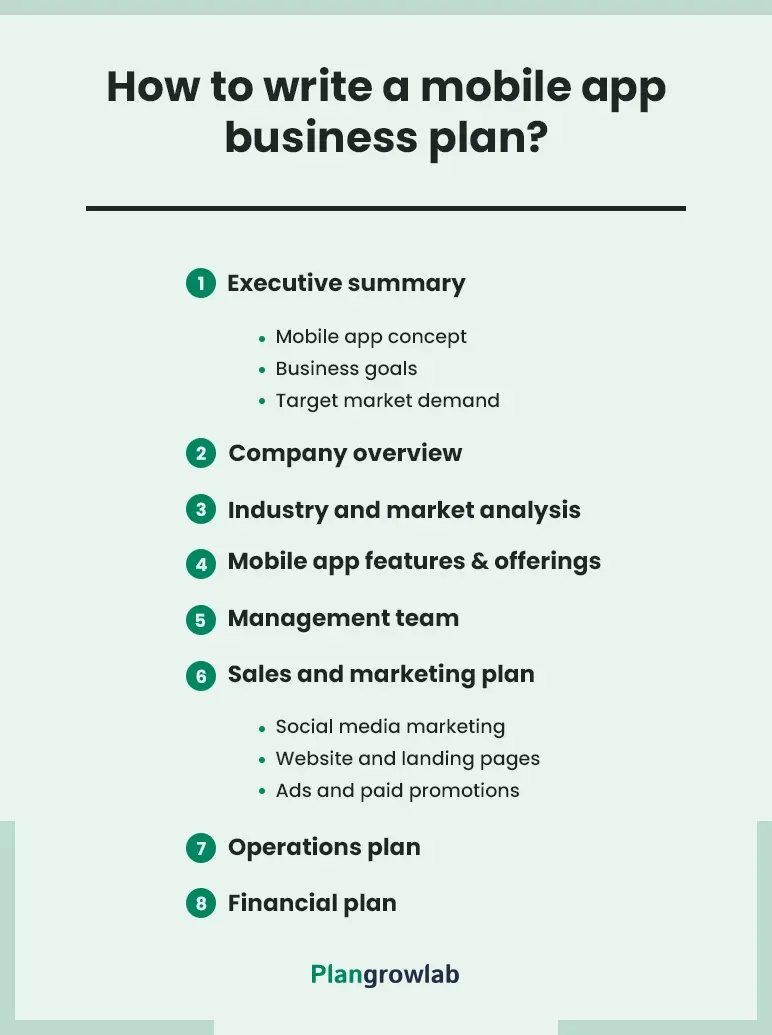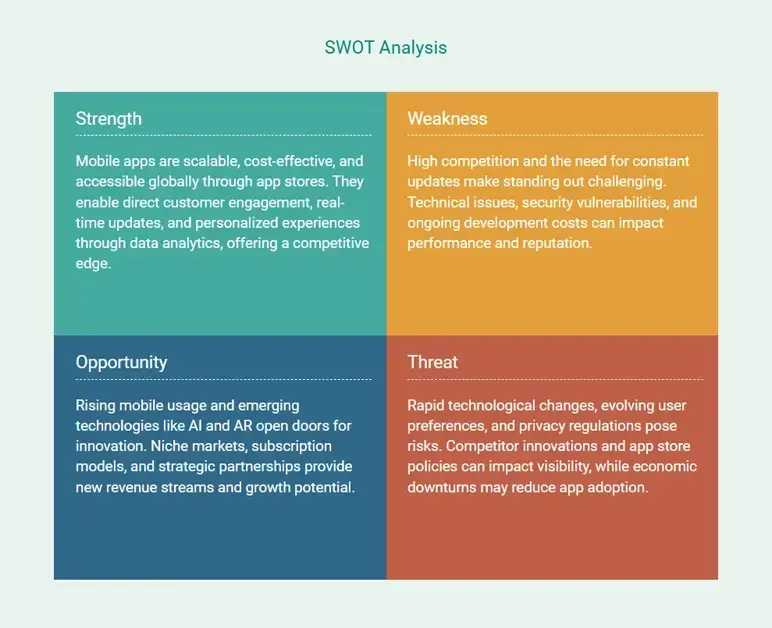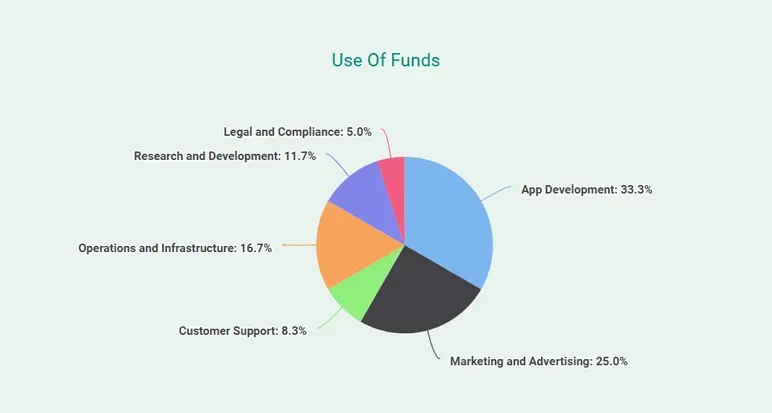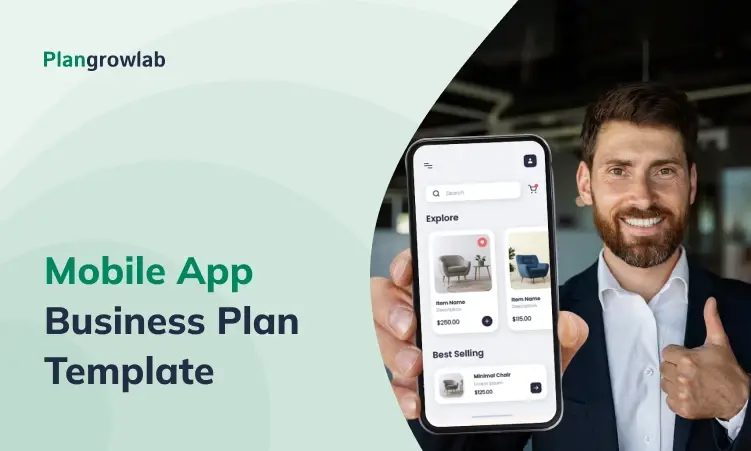Have you scrolled through your phone and thought: "Wow, this app could really take off"? Turning that idea into a successful app takes more than just an idea—you need a plan.
I recently caught up with Eugene Valkov, the product owner of “Start Mobile” based in Los Angeles. He shared how he went from sketching rough ideas in a notebook to building a successful app business.
Along the way, he had faced plenty of challenges, but he also learned what steps mattered most—and what mistakes to avoid.
This guide gives you helpful advice and a free template to create a mobile app business plan that helps you succeed.
Why create a business plan for a mobile app?
Having an idea for a mobile app is exciting, but turning that idea into a successful business is a whole different game. That’s where a business plan comes in—it’s your guide to making it work.
A business plan makes you think through the big questions, like:
- Who’s your app for?
- What problem does it solve?
- How will it make money?
Figuring this out early saves time, money, and stress later.
Investors aren’t handing out money for ideas alone. They want to see numbers, strategies, and proof that you’ve thought it through. Without a business plan, getting anyone to back you is tough.
And let’s be honest—apps are expensive. Development, marketing, and updates all add up. A business plan helps you budget wisely and avoid overspending.
How to write a mobile app business plan?
Here’s a straightforward guide that breaks down the business plan process step-by-step—no fluff, just what you need to get it done.

1. Executive summary
The executive summary is the first part of your mobile app business plan, but most people write it last. Why? Because it’s like a trailer for your mobile app development company—it highlights the best parts and gives a quick preview of what’s inside.
This section should grab attention, explain your idea, and give readers a clear idea of what’s coming next.
Here’s what to include in your plan summary:
- Mobile app concept – Describe your app idea in simple words. What problem does it solve? Who will use it? How does it make their life easier?
- Business goals – What do you want to achieve? Are you looking to hit 10,000 downloads in the first three months? Or maybe $50,000 in revenue by the end of the first year?
- Target market demand – Show that people want your app. Share a quick fact or trend to prove there’s demand.
- Marketing strategy – Explain how you’ll promote the app. Will you use social media ads, influencer partnerships, email marketing, or app store optimization?
- Financial highlights – If you need funding, say how much and what you’ll spend it on—like app development, marketing, or operations.
This section doesn’t need to be long, but it does need to be strong. It’s your chance to get people excited about your app.
"While writing the executive summary for my mobile app business plan the biggest hurdle was fitting everything important at one place—what the app does, who it’s for, and what makes it unique—into just a few paragraphs.
What I did was that I focused on highlighting the app’s core features, target audience, and revenue model without overexplaining it. I also kept revising until it was clear, concise, and attention-grabbing.” —Eugene Valkov
2. Company overview
The company overview section gives a quick overview of your mobile app startup—what it does, who it’s for, and why it matters.
Start with the basics—your app’s name and type. Is it a fitness tracker, budgeting tool, or shopping platform?
Next, explain what sparked the idea. Was it a problem you faced or an opportunity others missed? Highlight how your app solves it better than others.
Focus on your target users. Who is your app for, and what problem does it solve for them?
Then, cover the business side. Are you working solo or with a team? What’s your business structure—LLC, partnership, or something else?
Finally, share your vision. Where do you see your app in a few years? Talk about growth, features, or expansion plans.
“I knew what my app did, but putting it into words that explained why it mattered and who it was for felt harder.
The biggest challenge was trying to stand out in a market that was already packed with apps. I kept asking myself—what makes mine different?
That’s when I focused on breaking it down into sections like features, audience, and goals makes a huge difference.” —Eugene Valkov
3. Industry and market analysis
Before building your mobile app, figure out where it fits in the market.
Start by researching trends and analyzing competitors—both direct and indirect competitors. What do they do well, and where do they fall short? Highlight how your app is different and better.
Next, identify your target customers. Are they students, professionals, or busy parents? What problems do they face, and how does your app solve them? Knowing your audience makes marketing easier.
Conduct a SWOT analysis as given below to evaluate your app’s Strengths, Weaknesses, Opportunities, and Threats. This helps you identify what sets your app apart, areas for improvement, potential growth opportunities, and risks to prepare for.

Finally, consider growth. Is your market big enough to support your goals? Are there opportunities to expand later? Planning ahead sets your app up for success.
"The mobile app industry analysis section felt overwhelming at first because there’s so much data out there. I needed to figure out who my competitors were, what trends I should focus on, and whether the market was even worth entering.
I spent time digging through app store rankings, user feedback, and reports. Breaking it into smaller parts—market trends, competitors, and growth opportunities—made it easier to handle. —Eugene Valkov
4. Mobile app features & offerings
Mobile app services are the features and tools that make your app useful and easy to use. They’re what keep users coming back.
Start with the basics—smooth navigation, simple menus, and quick access to features. Users should be able to get things done without hassle or delays.
Next, focus on security. Features like secure logins, encrypted payments, and data protection give users peace of mind and build trust.
Then, think about extras that make your app stand out. Offline access, smart suggestions, and integrations with other platforms can take the user experience to the next level.
Finally, don’t forget updates. Users need change, and your app should keep up. Regular updates and improvements keep users happy and engaged.
"Writing about my app’s features was exciting but also tricky. I didn’t want to over-explain, but I needed to highlight what made it different.
I wrote in categories like core characteristics, upgrades, and future add-ons—to keep it simple.
Adding subscription options and premium features helped show growth potential. It felt good to finally see my app’s value written down." —Eugene Valkov
5. Management team
Your management team is the driving force behind your app’s success. Investors and partners aren’t just backing the idea—they’re backing the people who will bring it to life.
Start by introducing the key members of your team and their roles. Highlight their experience and achievements, whether it’s a developer who has built successful apps before or a marketing lead with a proven track record of driving sales.
Show how their skills make them the right fit to grow the business. Focus on what makes them qualified to take the app from idea to reality.
If you have advisors or mentors, be sure to include them. Having experienced people to guide you adds credibility and reassures investors that you have the support needed to avoid costly mistakes.
"When I first started, my team was small—just me and a couple of people handling the basics. It quickly hit me that I couldn’t do everything myself, so I had to figure out what roles to outsource right away, like marketing and design.
Writing this part actually made me think ahead. I focused on starting lean but also planned to add more people as the app grew." —Eugene Valkov
6. Sales and marketing plan
Now that you know who your target audience is, let’s talk about how you’re going to reach them. Marketing your mobile application starts with building awareness.
Here are some ways from which you can bring in potential customers and retain them:
- Social media marketing– The best platforms for spreading the word quickly and directly engaging with the users are Instagram, Facebook, and YouTube.
- Website and landing pages – Create a site where people can learn more, sign up for updates, or download the app.
- Ads and paid promotions – Use Google Ads and social media campaigns to boost visibility and drive traffic.
- Word-of-mouth and reviews – Encourage users to provide reviews and let them share with their networks, and offer referral programs or discounts that will encourage this.
- App store optimization (ASO) – Get a great app name, write a clear description, and upload some catchy screenshots to rank well in searches.
Lastly, partnerships can give you that little extra push. Engage influencers, bloggers, or other companies to increase your reach and get even more people talking about your app.
"Figuring out my mobile app marketing plan took time because there were so many directions I could go. I had to decide what would actually work instead of trying to do everything.
I started with affordable marketing strategies—social media ads, influencer shoutouts, and app store optimization. Then I added plans for partnerships and referral programs.
Once I mapped out each phase—pre-launch, launch, and post-launch—it all started to make sense." —Eugene Valkov
7. Operations plan
The operations plan explains how your mobile app development company will run behind the scenes. It covers what needs to happen daily, weekly, and monthly to keep the app working smoothly and meeting user expectations.
Start with the mobile app development process. Outline how updates, bug fixes, and new features will be handled.
Mention whether you’ll have an in-house app development team or outsource tasks to freelancers or agencies.
Next, talk about customer support. Users will have questions and issues, so explain how you’ll provide support—whether through email, chat, or a help center.
Then, cover maintenance. Regular updates, performance checks, and security upgrades keep the app running without problems. Detail how often these checks will happen and who will handle them.
"The operations plan forced me to think about how the app would get built and maintained. It wasn’t just about launching—it was about updates, fixes, and customer support.
The hardest part was organizing timelines and budgets. I worked with developers to set milestones and used tools to track progress. It helped me feel more prepared to handle the technical side."—Eugene Valkov
8. Financial plan
Let’s talk about numbers—how your mobile app is going to make money, stay profitable, and handle bumps along the way.
This section isn’t just for investors or lenders. It’s also for you—to make sure your app idea makes financial sense and can actually sustain itself.
Start with your financial projections for the next 3–5 years. Include:
- Income statement
- Balance sheet
- Cash flow statement
- Break-even analysis
Don’t forget to add up your startup costs, estimate revenue, and outline monthly expenses. Be clear about how much funding you’ll need and where it’s coming from.
Also, explain how the funds will be used—whether for app development, marketing, or scaling operations—to give a clear breakdown of spending priorities.

Also, think about risks. What could go wrong, and how will you handle it? Showing you’ve planned for challenges makes your business look more solid—and investors will notice.
"This was the most intimidating part. I had to figure out the mobile app development costs, marketing budgets, and revenue projections—all while knowing there’s always uncertainty with apps.
I listed everything—software tools, ad spending, and salaries—and used spreadsheets to estimate income statements from ads and subscriptions."—Eugene Valkov
Download now mobile app business plan template
Now, ready to create your mobile app business plan but still need extra help? Don’t worry—we are here! Download our free mobile app business plan template in PDF format.
This easy-to-use template is designed to help entrepreneurs outline their ideas, marketing strategies, and business goals step-by-step. With practical insights and examples, it simplifies the whole plan writing process.
Conclusion
You’ve got the idea. Now, it’s time to make it happen!
With this app development business plan guide and a free template, you can easily create the first draft of your plan.
However, if you need expert-level guidance, we’re here for you. Whether it’s business plan writing, reviewing, or crunching financial numbers, our comprehensive business plan consulting service has you covered.
So, what are you waiting for? Connect with us today!
Frequently Asked Questions
What are the key components of a comprehensive business plan for a mobile app?
A comprehensive business plan for a mobile app includes several key components that outline your vision, business strategy, and financial roadmap such as:
- Executive summary
- Company description
- Mobile App services
- Mobile app Industry and market analysis
- Sales and marketing strategy
- Management team
- Operations plan
- Financial plan
Do you need a business plan for an app?
Yes, absolutely! A business plan is crucial to secure funding, map out your app’s growth, and avoid costly mistakes. It gives you clarity on your app’s business goals, audience, and revenue model.
How much does it cost to write an app business plan?
The cost can range from $7 (or even free) to as high as $25,000, depending on whether you do it yourself, hire a professional, or use business planning software.
How long does it take to write a business plan for an app?
On average, it can take 2 to 6 weeks, depending on the type of business plan, level of detail, and research involved. Templates and AI tools can speed up the process significantly.
What are common mistakes made when drafting app business plans?
Common mistakes when drafting app business plans include:
- Overcomplicating the business plan
- Skipping through market research
- Unrealistic financial projections
- Ignoring marketing strategy
- No clear monetization plan

